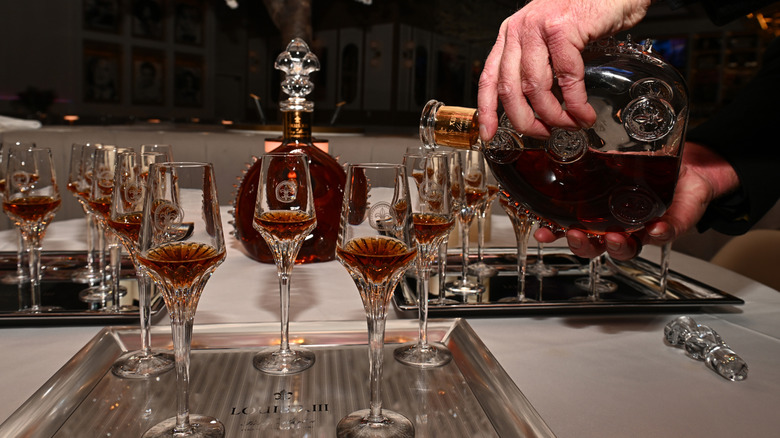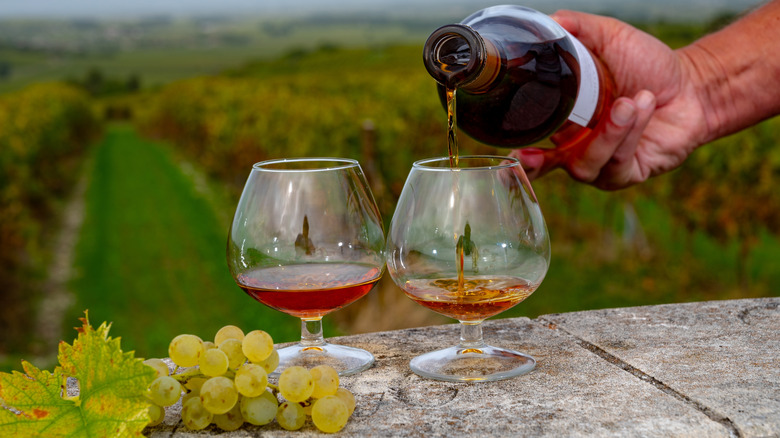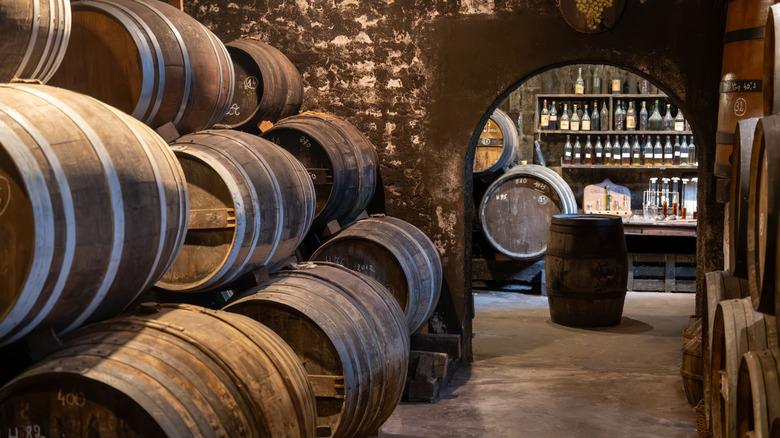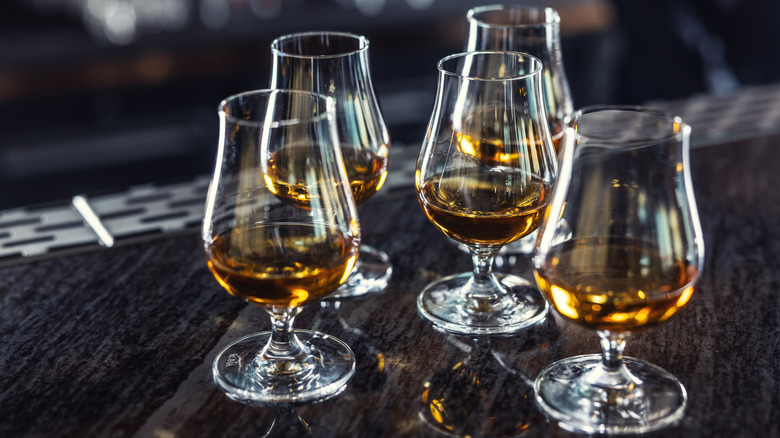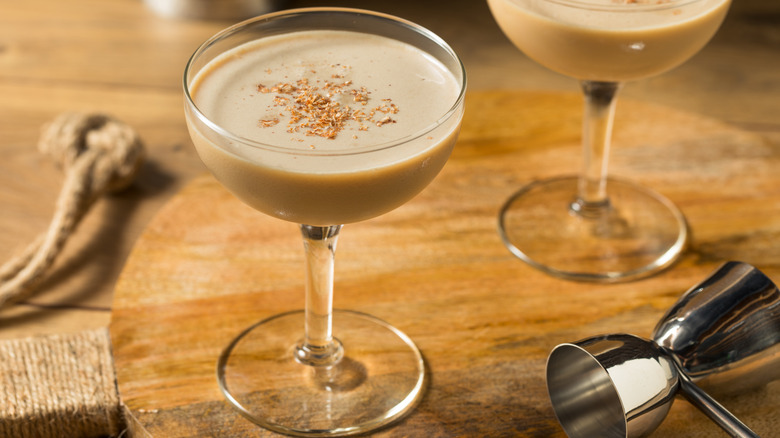What's The Difference Between Brandy And Cognac?
We may receive a commission on purchases made from links.
Mention Cognac and it likely conjures up an image of elegant men in smoking jackets: Their cigars send foul odors through the air in dark paneled rooms with dim lighting while they slowly sip drinks poured from cut crystal decanters into short, wide glasses called snifters. Mention brandy and the scene might very well be the same. But, because brandy is an overarching term for distilled spirits made from fermented fruit juice (of which Cognac is just one type), it can also stir up mental pictures of late nights spent in the backyard of a home distiller, drinking pisco or Applejack poured from a jug into whatever mismatched set of glasses are available.
Although "brandy" is derived from "brandwewijn," the Dutch term for "burned wine," brandy generally has a sweet but somewhat sharp flavor. This nomenclature doesn't help the common brandy myth that all brandies are made from grapes; they can also be made from other fruits such as apples, apricots, pears, plums, and cherries. As such, brandy types range from the refined and complex flavors of Armagnacs and Calvados to the more rugged and strong, smoky flavors of pisco, Grappa, and Applejack. But the most elegant of all — with bottles sometimes selling for thousands of dollars — is Cognac.
What is Cognac?
Cognac is to brandy what Champagne is to sparkling wine: A singular type of brandy with strict rules for its production. Like Champagne, Cognac has Appellation d'Origine Contrôlée (AOC) certification: A legal designation of how and where a product can be made in France. Other countries have similar appellation systems, such as the United States' American Viticultural Areas.
The first rule for Cognac production is where it is made. Cognac must be made in the eponymous region, which sits in western France north of Bordeaux. Within Cognac, there are six smaller domains: Grande Champagne, Petite Champagne, Borderies, Fins Bois, Bons Bois, and Bois Ordinaires. It must also be made from grapes in this region, such as Ugni Blanc (a grape variety more familiarly known as Trebbiano in Italy), Colombard, Folle Blanche, Montils, Sémillon, and Folignan. It is then twice-distilled in copper pots and aged.
What distinguishes Cognac from other brandies
Other than image, Cognac's distillation process, aging, and alcohol content help distinguish it from other brandies. Unlike its cousin Armagnac, another type of brandy made further south in its own AOC, Cognac is distilled twice. The product of the first distillation is called brouillis. Eau-de-vie, French for "water of life," is the end product of the second distillation. Under the AOC, eau-de-vie must be aged in French oak barrels for a minimum of two years, but it is often aged longer to develop stronger, fuller flavors.
Cognac producers often use a labeling system indicating the age of the youngest Cognac in the bottle, although there's some disagreement over the specific number of years indicated by each. Some of these labels include VS (Very Special), which must be aged at least two years, VSOP (Very Superior Old Pale), which must be aged at least four years (and is the best place for beginning Cognac drinkers to start), and XXO (Extra Extra Old), which must be aged at least 14 years. Other labels you might find on bottles are Vieille Réserve, Napoléon, and XO (Extra Old), which are aged between five and 10 years. But again, the age of some labels can depend on who you ask. For the alcohol content, under the AOC, Cognac must have an alcohol by volume of at least 40%. In the United States, brandy must have an ABV of at least 40%, but some have an ABV as high as 60%.
Taste differences between brandy and Cognac
Cognac is drier than most brandies; partly because it's made with a dry white wine, but also because it can be sweetened with no more than 1.5 grams of sugar per liter. Young Cognacs tend to have a spicy aroma while aged bottles have more oak flavor and a tannic yet smooth, velvety texture. Some Cognacs are distilled with lees (the residual yeast and other solid materials left by wine production), giving them a richer flavor.
It's hard to pin down the taste of other brandies since it depends on the fruit they're made from, their age, and their distillation process. Most tend to be sweet, with flavors of fresh and dried fruit and a hint of vanilla from the oak. Even those brandies made from grapes and wine can taste quite different from one another since many different grape cultivars are used, as is the case with Armagnac. Cognac's other French cousin is Calvados, a brandy made in the Normandy region from apples and pears.
Some non-French brandies include pisco, which is made from grapes in Chile and Peru, Brandy de Jerez, which is made in Spain's Sherry Triangle region from grapes and other fruits, Kirschwasser, which is made from cherries, and Grappa. Once known as a poor man's drink, Grappa is now under a protected designation and must be made in Italy, part of Switzerland, or San Marino. Unlike other wine-based brandies, Grappa is made from pomace – the skin, pulp, seeds, and stems leftover from winemaking.
How to drink Cognac and brandy
Cognac can be enjoyed on its own or in cocktails. Aged Cognacs are often served neat in a brandy snifter while younger Cognacs are mixed into cocktails. Probably the best-known Cognac cocktail is the Sidecar, made with orange liqueur and lemon juice. The Brandy Alexander is also popular and often uses Cognac, along with cream and crème de cacao.
How brandy is served depends largely on the type of brandy. Most can be consumed on their own or on the rocks. In cocktails, brandy is rarely mixed with sodas or other high-volume mixers; instead, it's usually blended with creamy ingredients that balance brandy's strong flavor. For example, the Pisco Sour is made with egg whites that give the drink a creamy feel. The experience of drinking brandy can vary widely depending on the type you're drinking, but if you're in the mood for elegance, Cognac is the way to go.
